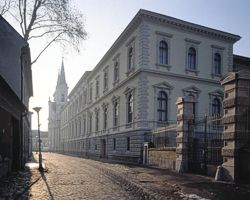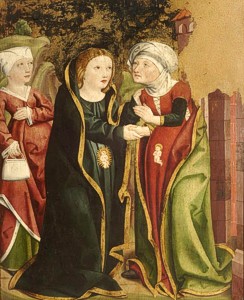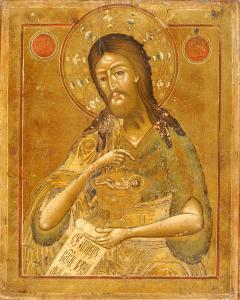VISITATION AND ST. JOHN THE BAPTIST 15TH AND 17TH CENTURIES, THE CHRISTIAN MUSEUM, ESZTERGOM, HUNGARY
AROUND THE WORLD AND THROUGH THE CENTURIES WITH THE UNBORN
CHRIST CHILD
The Christian Museum
Visitation 15th Century
St. John the Baptist (parts of a Deesis) 17th Century
This panel showing the meeting of Mary and Elizabeth was once in the village of Csegöld in Szatmár County in East Hungary. It was probably painted in the last years of the 15th century, tempera and gold on wood, and its style is close to the works created in Upper Hungary. In the company of a servant, the expectant Virgin visits her relative, Elizabeth, who is also with child. This is a frequently represented scene of the Virgin's life, following the Annunciation. It is unusual, however, that the unborn babies are painted on the exterior of their mothers' wombs. The Christ child turns with a blessing gesture towards the little Saint John the Baptist who is kneeling in adoration.
St. John the Baptist (parts of a Deesis)_ Moscow, late 17th c._tempera and silver on wood_. The above painting is an example of one tradition of St. John the Baptist icons. In these icons the adult John the Baptist is portrayed pointing to Christ Unborn. In his left hand he holds a chalice or charger and a scroll that reads, "Behold the Lamb of God which taketh away the sins of the world". With his right hand he points to the Christ Child (unborn).
"St. John the Baptist is the Lord's immediate precursor or forerunner, sent to prepare his way. "Prophet of the Most High", John surpasses all the prophets, of whom he is the last. He inaugurates the Gospel, already from his mother's womb welcomes the coming of Christ, and rejoices in being "the friend of the bridegroom", whom he points out as 'the Lamb of God, who takes away the sin of the world'." Catechism of the Catholic Church, Article 3, 523.
"...when at her greeting, John (in the womb of Elizabeth and not yet born) was stirred with prophetic exaltation-as if even in his mother's womb he were already crying out, 'Behold the Lamb of God, behold the one who takes away the sins of the world'." St. Leo the Great (A.D. 400?-461) Sermon 35
Visit the blog version of: Unborn Word of the day




